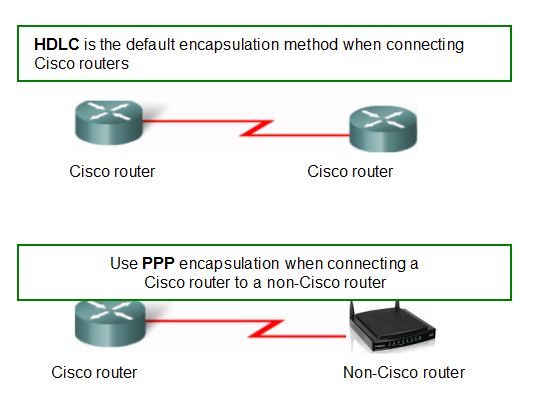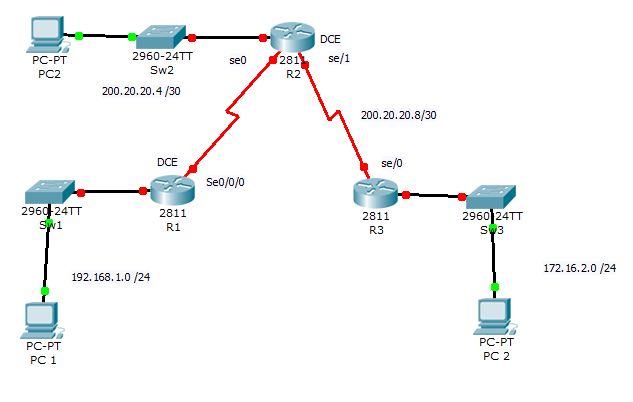
What is PPP?
Point-to-Point connection is one of the most common types of WAN connection. PPP connections are used to connect LANs to service provider WANs, and to connect LAN segments within an organization network. A LAN-to-WAN point-to-point connection is also referred to as a serial connection or leased-line connection, because the lines are leased from a carrier (usually a telephone company) and are dedicated for use by the company leasing the lines.
Simply, when you establish a connection to your ISP (Internet Service Provider) through a modem. The connection between the ISP and you make up two points on the network. Therefore, the protocol that is used for establishing this connectivity between the two of you is the Point-to-Point Protocol or the PPP.
Note: The default serial encapsulation method when you connect two Cisco routers is HDLC. This means, Cisco HDLC can only work with other Cisco devices. However, when you need to connect to a non-Cisco router, you should use PPP encapsulation. This is one of many advantages to using PPP it is not proprietary.
PPP can be used over twisted pair, fibre-optic lines, and satellite transmission. PPP provides transport over ATM, Frame Relay, ISDN and optical links. For security, PPP allows you to authenticate or secure connections using either Password Authentication Protocol (PAP) or the more effective Challenge Handshake Authentication Protocol (CHAP).
PPP is used to carry out the following functions
- Data Encapsulations: this is a method used to encapsulate multi-protocol datagrams. Different network-layer protocols are simultaneously transported and encapsulated over the same link, the flexibility of the PPP design enables it to be compatible to most supporting network devices.
- Link Control Protocol: The LCP is used to establish, configure, and test the data link connection. It’s flexible in handling different sizes of packets, detect a looped-back link, configuration errors, and terminate the link.
- Network Control Protocol: NCP is used for establishing and configuring different Network layer protocols. PPP enables the simultaneous use of multiple Network layer protocols. Some of the more familiar NCPs are:
- Internet Protocol Control Protocol
- AppleTalk Control Protocol
- Novell IPX Control Protocol
- Cisco Systems Control Protocol
- SNA Control Protocol
- Compression Control Protocol.
How to configure PPP on Cisco Router?
You can configure point-to-point encapsulation, software compression, link quality monitoring, load balancing across links (multilinks) on R1, R2 and R3 serial interface below.
Before you actually configure PPP on a serial interface, we will look at the commands and the syntax of these commands as shown below. This series of examples shows you how to configure PPP and some of the options.
1. How to enable PPP on an Interface
To set PPP as the encapsulation method used by a serial or ISDN interface, use the encapsulation ppp interface configuration command.
The following example enables PPP encapsulation on serial interface 0/0/0:
R1#config t
R1(config)#interface se 0/0/0
R1(config-if)#encapsulation ppp
R1(config-if)#end
The encapsulation ppp command has no arguments, however, you must first configure the router with an IP routing protocol (RIP, EIGRP or OSPF) to use PPP encapsulation. You should recall that if you do not configure PPP on a Cisco router, the default encapsulation for serial interfaces is HLDC.
2. How to configure Compression
You can configure point-to-point software compression on serial interfaces after you have enabled PPP encapsulation. Because this option invokes a software compression process, it can affect system performance. If the traffic already consists of compressed files (.zip, .tar, or .mpeg, for example), do not use this option.
To configure compression over PPP, enter the following commands:
R1(config)#interface serial 0/0/0
R1(config-if)#encapsulation ppp
R1(config-if)#compress [predictor | stac]
R1(config-if)#end
3. How to configure Link Quality Monitoring
One of the primary functions of LCP when establishing a PPP session includes testing of a link to determine whether the link quality is sufficient to use Layer 3 protocols. The command ppp quality {percentage} ensures that the link meets the quality requirement you set; otherwise, the link closes down.
How Link Percentage is calculated
The percentages are calculated for both incoming and outgoing directions. The outgoing quality is calculated by comparing the total number of packets and bytes sent to the total number of packets and bytes received by the destination node. The incoming quality is calculated by comparing the total number of packets and bytes received to the total number of packets and bytes sent by the destination node.
If the link quality percentage is not maintained, the link is deemed to be of poor quality and is taken down. Link Quality Monitoring (LQM) implements a time lag so that the link does not bounce up and down.
Use the configuration commands below to monitor the data traffic on the link and avoids frame looping:
R1(config)#interface serial 0/0/0
R1(config-if)#encapsulation ppp
R1(config-if)#ppp quality 80
R1(config-if)#end
Use the no ppp quality command to disable LQM.
4. How to Configure Load Balancing Across Links (MultiLinks)
Multilink PPP (also referred to as MP, MPPP, MLP, or Multilink) provides a method for spreading traffic across multiple physical WAN links while providing packet fragmentation and reassembly, proper sequencing, multivendor interoperability, and load balancing on inbound and outbound traffic.
MPPP allows packets to be fragmented and sends these fragments simultaneously over multiple point-to-point links to the same remote address. The multiple physical links come up in response to a user-defined load threshold. MPPP can measure the load on just traffic into the network, or on just traffic going out, but not on the combined load of both inbound and outbound traffic.
Use the following commands to perform load balancing across multiple links:
R1#config t
R1(config)#interface se0/0/0
R1(config-if)#encapsulation ppp
R1(config-if)#ppp multilink
R1(config-if)#end
The multilink command has no arguments. To disable PPP multilink, use the no ppp multilink command
—Original guide from orbit-computer-solutions.com




